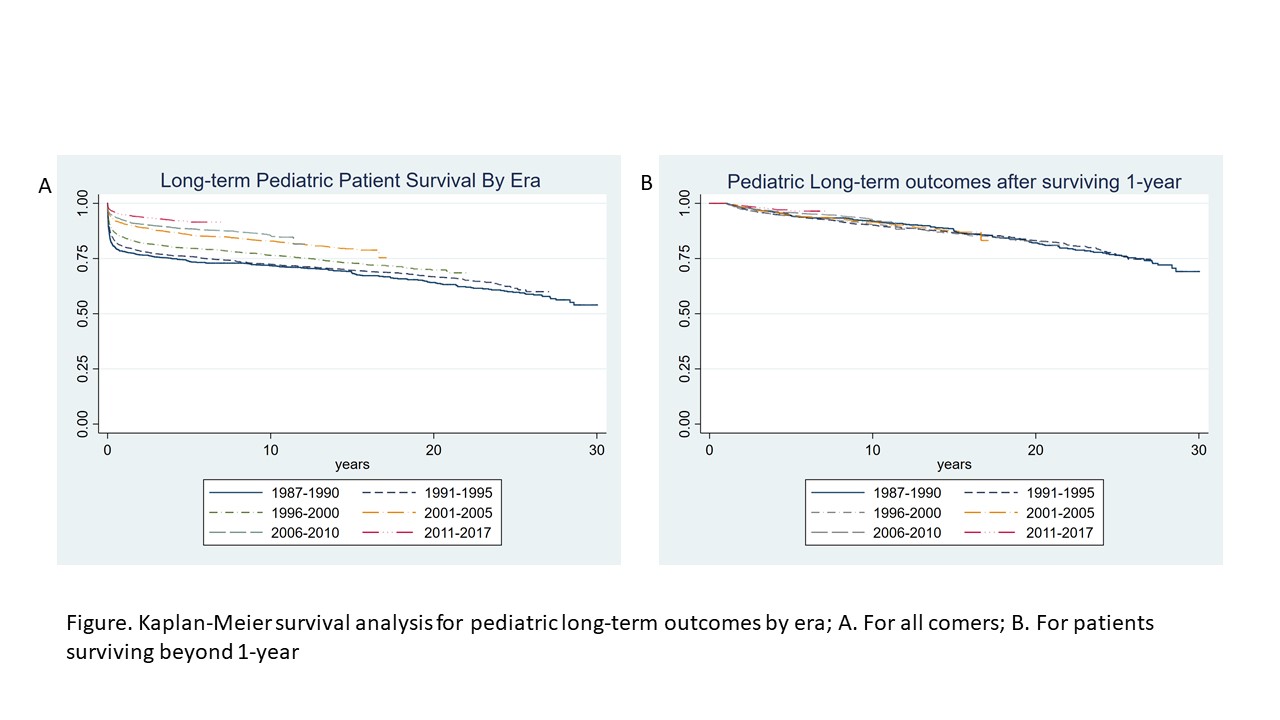No Gains In Long-term Survival Of Pediatric Patients After Liver Transplantation – A Three Decade Analysis
Baylor College of Medicine, Houston, TX
Meeting: 2019 American Transplant Congress
Abstract number: 496
Keywords: Liver transplantation, Outcome
Session Information
Session Name: Concurrent Session: Liver: Pediatrics
Session Type: Concurrent Session
Date: Tuesday, June 4, 2019
Session Time: 2:30pm-4:00pm
 Presentation Time: 2:54pm-3:06pm
Presentation Time: 2:54pm-3:06pm
Location: Room 210
*Purpose: The aim of this study was to assess improvements in long-term survival of pediatric patients after liver transplantation, by analyzing outcomes in transplant recipients who survived beyond 1 year after transplantation. Liver transplantation remains the only definitive therapy for children with end-stage liver disease, and has been the standard of care for over three decades. There has been a marked increase in the one-year survival of pediatric patients, from 78% in transplant recipients between 1987 and 1990 to 95% in transplant recipients between 2011 and 2017. However, the long-term outcomes have not seen a similar trend, and it is therefore crucial to shift priorities towards analyzing why this is the case.
*Methods: We analyzed 13,753 pediatric patients who survived for 1-year after receiving orthotopic liver transplantation between 1987 to 2017. The study period was divided into eras: 1987-1990, 1991-1995, 1996-2000, 2001-2005, 2006-2010, and 2011 onwards. Outcomes were analyzed using the Kaplan-Meier method for time-to-event analysis, and multivariable Cox regression.
*Results: There were no significant gains in unadjusted long-term outcomes among 1-year survivors over the past three decades (Figure). The log-rank tests for equality of survivor functions between each era and 1987-1990 were not statistically significant. Cause of death analysis revealed that although infections caused 20.6% of deaths in patients transplanted between 1987-1990, this number dropped to 5.6% in those transplanted between 2011-2017 (p=0.01). Furthermore, malignancy caused 10.6% of deaths in 1987-1990 but caused 22.2% of the deaths in 2011-2017 (p=0.04).
*Conclusions: Despite the gratifying gains in short-term survival of pediatric patients, 1-year survivors have no significant improvements in long-term survival after undergoing a liver transplantation. Long-term sequelae of immunosuppression, such as malignancy and infection, continue to be the most common causes of death. This study highlights the importance of better long-term management of immunosuppression.
To cite this abstract in AMA style:
Bakhtiyar S, Rana A, Ahmed S, Naseem H, Kueht M, Galvan NT, Cotton RT, O'Mahony CA, Goss JA. No Gains In Long-term Survival Of Pediatric Patients After Liver Transplantation – A Three Decade Analysis [abstract]. Am J Transplant. 2019; 19 (suppl 3). https://atcmeetingabstracts.com/abstract/no-gains-in-long-term-survival-of-pediatric-patients-after-liver-transplantation-a-three-decade-analysis/. Accessed December 22, 2025.« Back to 2019 American Transplant Congress

